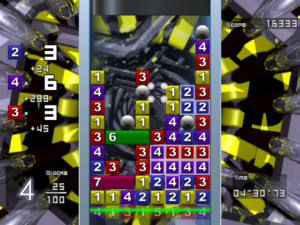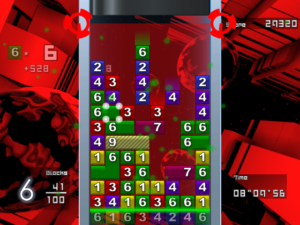Blocksum would almost certainly have become a major success has it been released as a modern mobile game in this post-Threes world of number-swiping puzzle games. As it stands, this game is a fantastic and frantic entry from the distant past which was a bit too ahead of its time.
The gameplay here is easy to learn and hard to master, making this game perfect for both short bursts and long hours of high score chasing. Numbered blocks rise in rows from the bottom of the screen and can be made to raise faster still by holding down the ‘B’ button (X by default on a keyboard). You can full control of a cursor the size of a single block and holding down the ‘A’ button (Z by default) while the cursor is over a block and moving in any direction will that block with the next block, turning them into a single, two-tile block with a value equal to the sum of the two combined blocks. Any number of blocks can be combined with each other and they don’t need to be in perfect lines and making ‘L’ shapes or stranger configurations can often help, but combining too many blocks into a single unit can lead to a disaster.
The actual goal of the game is to make groups of blocks equal or greater in quantity to their value to make them disappear and score points. If you are making a group of ‘4’ blocks the group must consist of four or more blocks with the exact value of ‘4’, a group of ‘6’ blocks must consist of a group of six or more blocks with the exact value of ‘6’ and so on. Blocks do not immediately disappear once the grouping conditions are met. Instead, the rows of blocks will temporarily stop rising and the blocks which are part of the group will glow and no longer be possible to manipulate. At this point, you have a short amount of time in which you can either start to create a separate group to score without needing to worry about the blocks rising to the ceiling or, preferably, you can combine more blocks near the group to add to it and reset the scoring timer.

The core design of Blocksum allows its risk and reward elements to organically grow as the game goes on. Chains consisting of a larger amount of blocks (regardless of the physical size or shape of each block) are worth significantly more points than smaller chains and higher numbers are worth more than lower ones. At the start of the game you are only given ‘2’ and ‘1’ blocks, though the variety of default block values and the most common values for blocks rises as the game progresses. Since the starting values for your blocks are so low, you can’t make too many points early on; you can either make a large chain of low-value blocks or combine a bunch of the blocks to make a small chain of high-value ones. Thus, as the values of the blocks rise and become more varied it becomes more difficult to make a common number, but it also requires a far lower amount of default blocks to meet the minimum requirements for things like a group of eight ‘8’ blocks or ten ‘10’ blocks and using all or most of the screen for a single chain will net a huge amount of points.
Like in most block-based puzzle games, making combos will gradually increase the level and the speed at which the blocks rise rapidly increases along the way. If a block touches the top of the screen the blocks will stop rising and two red rings will appear at the bottom on the sides of the play area. These rings will rise upward until the top of the screen is clear and the game will end if the rings themselves touch the top. Even if you don’t immediately see a solution, making a combo anywhere at all will make the rings pause for the duration of the combo, giving you more time to search for and set up a way to reduce the height of the offending column. Metallic orbs will sometimes appear within the rows of numbered blocks. Orbs can get in the way and make it difficult to make matches if you don’t clear off the blocks above them, but they are very powerful. ‘Matching’ a block with an orb will immediately remove all blocks of that value from the field. Blocks removed with an orb don’t grant points, but it’s a great way to get rid of blocks which are getting in the way or which you have accidentally combined; you can even combine every block on the screen into a single, enormous block and match it with an orb to clear the screen if things are looking particularly bad.

The aesthetics fit this game perfectly. Every value has a different block color, which adds a bit of visual flair while merging blocks into higher numbers and makes it much easier to pick out specific numbers and quickly create chains. There is a sense of urgency to the appropriately electronic and techno soundtrack which goes well with the fast-paced speed of the gameplay and every sound effect has a great sense of ‘weight’, especially the sound blocks make when you complete or add to a combo chain. Even the swirling, changing backgrounds help to add some thrill to this game which would be harder to accomplish with still images. It’s a fast-paced, high energy game and every piece of the aesthetic matches it.
There aren’t multiple game modes here or difficult selections, but this isn’t a game which needs those. Blocksum is a straightforward, streamlined, exciting, and deceptively simple puzzle game which can compete with the best entries the genre has to offer.